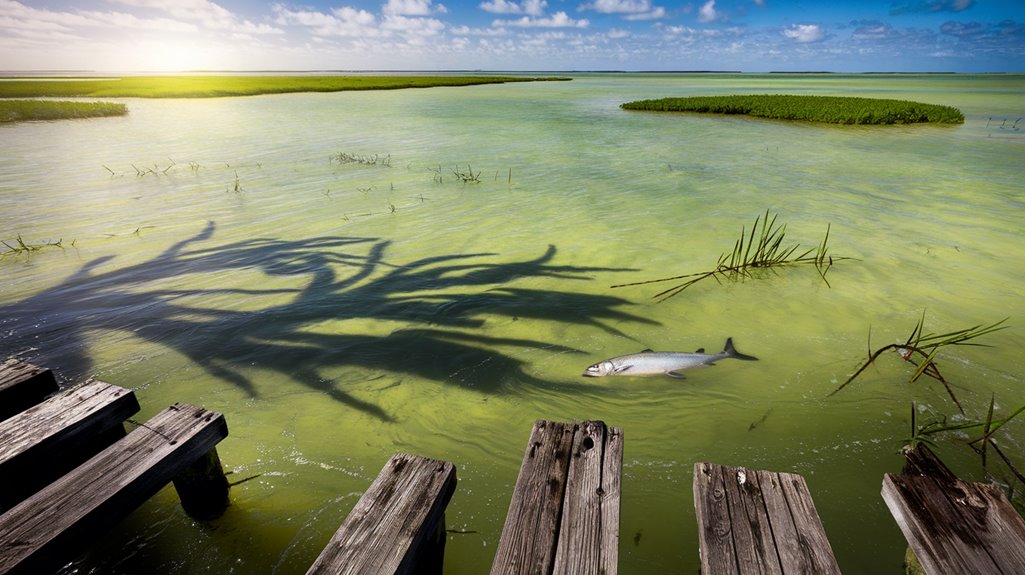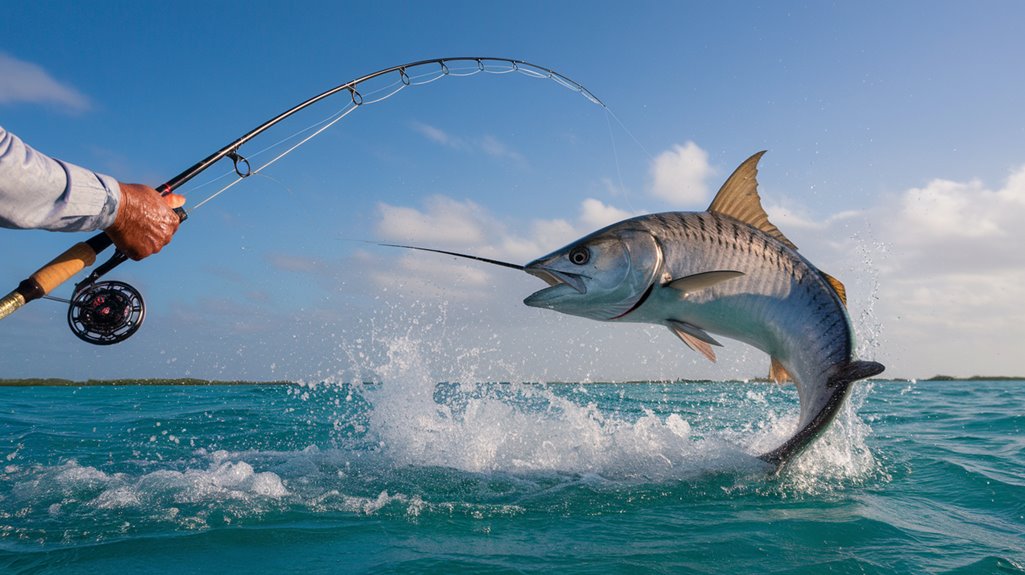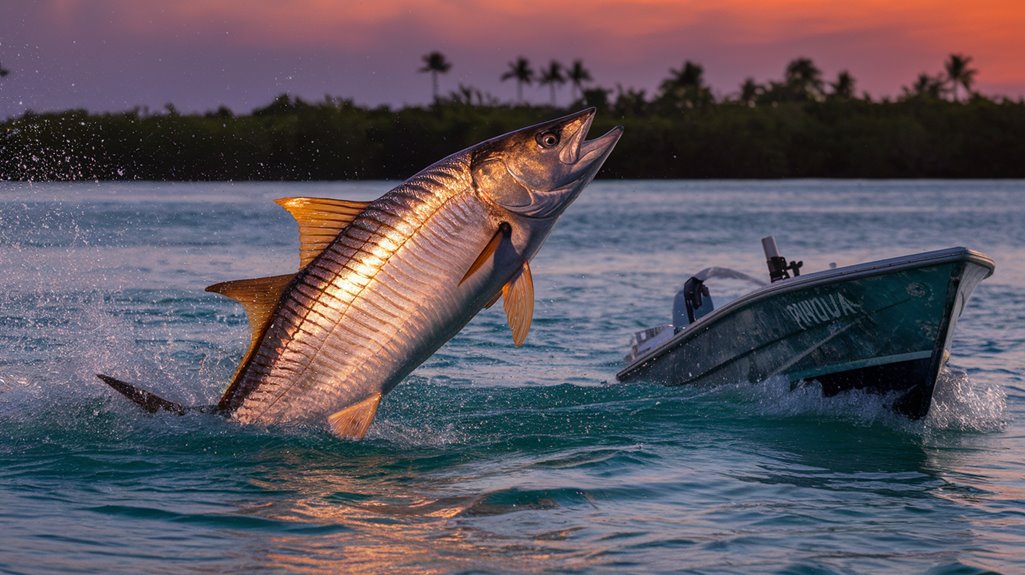You'll discover that tarpon fishing in Key West isn't just about throwing a line in the water and hoping for the best. These majestic "silver kings" demand specific techniques, precise timing, and intimate knowledge of their habits. Whether you're positioning near the Harbor's bridge pilings at dawn or drifting along mangrove edges during the spring migration, your success hinges on mastering the essential elements that separate casual anglers from consistent trophy hunters.
- Key Takeaways
- Essential Gear Selection for Trophy Tarpon
- Prime Fishing Spots Around Key West Harbor
- Mastering Live Bait Techniques
- Understanding Tidal Patterns and Movement
- Seasonal Migration Strategies
- Advanced Hook-Setting Methods
- Effective Fighting Tactics and Control
- Weather Reading and Water Conditions
- Frequently Asked Questions
- Conclusion
Key Takeaways
- Fish during moving tides at Key West Harbor channel edges, where tarpon actively feed on concentrated baitfish schools.
- Focus fishing efforts during dawn and dusk when water temperatures are between 75-85°F for optimal tarpon activity.
- Use 20-30 pound fluorocarbon leader with circle hooks when live-baiting with mullet or pilchards around bridge pilings.
- Master the bowing technique during tarpon jumps and maintain high rod position to prevent line breaks.
- Target mangrove areas from April through June, then shift to deeper channels during peak summer months.
Essential Gear Selection for Trophy Tarpon
When pursuing trophy tarpon in Key West's crystal-clear waters, you'll need to arm yourself with gear that can handle these magnificent fighters. For fly fishing enthusiasts, select a 10-12 weight fly rod paired with a robust reel featuring a smooth drag system that can withstand powerful runs.
If you prefer spinning tackle, opt for a 20-30 pound class setup with a reel that holds at least 200 yards of braided line. Don't skimp on your leader – 20-30 pound fluorocarbon provides the ideal balance of stealth and strength. Regardless of your approach, always use circle hooks to maximize hookups and protect these prized gamefish.
Stock your tackle box with a mix of Tarpon Fishing Lures and live bait options like mullet, pilchards, and crabs. This versatile selection guarantees you're prepared for changing conditions and feeding patterns.
Prime Fishing Spots Around Key West Harbor
You'll find consistent tarpon action along Key West Harbor's main channel edges, where the fish stack up during tidal movements to ambush passing bait. The bridge pilings come alive at night as tarpon gather under the lights to feed on attracted baitfish, offering excellent opportunities for nighttime casting. The mangrove-lined edges of the harbor provide natural pathways for migrating tarpon, particularly during the spring run when you can sight-cast to rolling fish in the early morning hours.
Harbor Channel Hot Zones
The Key West Harbor Channel stands out as one of the most productive tarpon fishing zones in the Florida Keys, featuring multiple prime locations where these silver kings regularly gather. You'll find the best catch rates by targeting docks and bridges during tidal changes, where tarpon naturally congregate. For best results, approach these hot zones quietly to avoid spooking your prey.
| Location | Best Time | Technique |
|---|---|---|
| Bridge Posts | Tide Change | Live Bait |
| Shallow Flats | Dawn/Dusk | Sight Fishing |
| Dock Areas | High Tide | Chumming |
| Channel Edges | Outgoing Tide | Drift Fishing |
When fishing the shallow flats adjacent to the harbor channel, watch for rolling tarpon and maintain stealth. Consider using shrimp boat by-catch as chum to attract more fish to your location.
Night Fishing Bridge Spots
As darkness descends over Key West Harbor, prime bridge spots transform into tarpon-fishing havens where anglers can capitalize on the species' nocturnal feeding patterns. You'll find exceptional opportunities at both the Long Key Bridge and 7-Mile Bridge, where lights attract baitfish and, subsequently, feeding tarpon.
To maximize your success, position yourself near the bridge pilings during moving tides, when tarpon are most actively hunting. You'll want to use live bait – mullet or crabs work best – as these match the natural prey tarpon seek at night. Remember that stealth is vital; these fish are particularly wary in low-light conditions. Keep your movements quiet and deliberate when approaching your chosen spot, and you'll increase your chances of connecting with these powerful gamefish during their prime feeding activity.
Mangrove Edge Tarpon Runs
While Key West Harbor boasts numerous fishing spots, mangrove-lined edges provide some of the most productive tarpon runs in the area. You'll find these game fish actively feeding along the mangrove edges during tidal changes, making these locations prime targets for your fishing efforts. The channels adjacent to mangroves are particularly effective, as they're natural ambush points where tarpon hunt for baitfish.
For best results, try sight-casting during early morning or late afternoon when tarpon are most active. You'll spot them rolling near the mangroves in the clear waters. To increase your chances, use live bait like mullet or pilchards – these naturally occur in these areas and will attract feeding tarpon. Position yourself strategically along these edges where the fish have established regular feeding patterns.
Mastering Live Bait Techniques
Successful tarpon fishing in Key West hinges on mastering live bait techniques that mimic natural feeding patterns. You'll need to select the right bait – mullet, pilchards, or crabs – and match them to tarpon's feeding habits. Using 4-6 inch baits with circle hooks guarantees better hookups while supporting catch-and-release practices.
- Present your live bait with slow, steady retrieves to imitate natural movement
- Deploy a chum bag filled with shrimp boat by-catch to attract feeding tarpon
- Use circle hooks to increase hook-up ratios and reduce fish injury
- Select bait size between 4-6 inches for best results with adult tarpon
Understanding Tidal Patterns and Movement

Understanding tidal patterns holds the key to consistently landing tarpon in Key West waters. You'll want to time your fishing trips around the moving tides, as tarpon become most active during these periods. The incoming and outgoing tides create strong currents that attract baitfish, which in turn draws hungry tarpon to channels and bridge areas.
To maximize your success, focus on fishing during early morning and late afternoon feeding times when the tide is moving. You'll find tarpon congregating in areas with powerful currents, especially during tidal changes. By studying local tidal charts and understanding how these patterns affect fish movement, you can predict prime locations where tarpon will gather. This knowledge will greatly improve your chances of encountering these powerful gamefish in Key West's dynamic waters.
Seasonal Migration Strategies
To consistently land tarpon in Key West, you'll need to adapt your fishing strategy to their seasonal migration patterns. These powerful fish move from deeper Caribbean waters into shallow waters during spring and summer months, following specific patterns that savvy anglers can exploit.
Your success depends on understanding these key migration habits:
- Target mangrove areas from April through June for smaller tarpon
- Focus on deeper channels and flats during peak summer months
- Fish during tidal changes when these opportunistic feeders are most active
- Monitor water temperatures, staying within the 75-85°F sweet spot
While the heaviest migration occurs April through June, don't overlook late summer opportunities when fishing pressure decreases but tarpon remain active. By matching your approach to their seasonal movements, you'll maximize your chances of success.
Advanced Hook-Setting Methods

Mastering proper hook-setting techniques marks the difference between hooking and losing these powerful gamefish. When implementing advanced hook-setting methods for tarpon fishing, you'll need to adapt your approach based on your chosen bait. With live bait fishing, opt for circle hooks that naturally set as the fish turns away – just maintain slight line tension and let the hook do its work. When using artificial lures, you'll want to set the hook quickly and firmly once you feel the strike.
For both techniques, timing is essential. Wait for the tarpon to fully commit to the bait before executing a swift upward motion with your rod and reel. Once hooked, remember to bow when the fish jumps to prevent losing your solid hook set. This essential technique gives the tarpon room to land without dislodging the hook.
Effective Fighting Tactics and Control
Once a tarpon is hooked, your success hinges on maintaining constant control throughout the fight. Your fishing skills will be tested during tarpon season, especially when managing these powerful gamefish. Remember to keep your rod tip elevated while applying steady side pressure, which proves essential for maintaining control during intense battles.
- Keep your fly rod positioned high, creating ideal tension to prevent the tarpon from shaking loose
- Master the bowing technique when the fish jumps to reduce strain on your line
- Adjust your drag settings precisely for those powerful runs that define tarpon fights
- Position yourself strategically in the boat, using your body weight to counter the fish's movements
These techniques will greatly improve your odds of landing these magnificent fighters, particularly during the peak of tarpon season when the action is most intense.
Weather Reading and Water Conditions
You'll find tarpon feeding most actively when water temperatures hover between 75-85°F, with their peak activity occurring during early morning and late afternoon tidal changes. Your success rate increases dramatically when you track clear water conditions and strong currents around bridges and channels, where tarpon naturally congregate. Weather patterns, particularly during tropical storm season, will directly influence the tarpon's behavior, so you should monitor approaching fronts and adjust your fishing schedule to capitalize on pre-storm feeding frenzies.
Weather's Impact On Feeding
Understanding how weather patterns influence tarpon feeding behavior is essential for a successful fishing expedition in Key West. You'll find tarpon activity peaks during low-light conditions, particularly at dawn and dusk when they're naturally programmed to feed.
Here's what you need to monitor for prime feeding opportunities:
- Water temperature between 75-85°F – below 70°F greatly reduces feeding
- Tidal changes during incoming and outgoing movements
- Overcast skies that enhance visibility and make tarpon feel secure
- Barometric pressure shifts, especially drops that trigger increased activity
Watch for these weather conditions to align, and you'll maximize your chances of success. Remember that storms can disrupt feeding patterns, but the period just before weather changes often brings heightened activity as tarpon sense the approaching system.
Tracking Optimal Tidal Flows
To maximize your tarpon fishing success in Key West, mastering the art of reading tidal flows and weather conditions becomes paramount. You'll want to focus your fishing efforts during periods of moving water, as tarpon are most active during strong tidal flows. Watch for water temperatures between 75-85°F, which trigger ideal feeding patterns.
Tracking the lunar calendar gives you an extra edge, as full moons create stronger currents that stimulate increased tarpon activity. Time your outings during dawn or dusk when low-light conditions improve visibility and feeding behavior. Pay close attention to incoming and outgoing tides, as these changes create prime opportunities for catches. By combining tidal movement knowledge with temperature monitoring and lunar phase awareness, you'll greatly boost your chances of landing these prized gamefish.
Frequently Asked Questions
What Is the Best Month to Catch Tarpon in the Keys?
You'll find May is your prime month for tarpon fishing in the Florida Keys, though excellent opportunities extend from April through June when massive schools migrate through shallow waters during peak season.
How Old Is a 100 Pound Tarpon?
With tarpon living up to 50+ years, you'll find a 100-pound specimen is typically 10-15 years old, as they grow roughly 1-2 pounds annually during their early years.
What Is the Best Rig for Tarpon Fishing?
You'll need a 20-30 pound fluorocarbon leader with circle hooks, paired with live bait or weighted flies. Add a small sinker above your hook to maintain natural bait movement in the water.
How to Catch Tarpon in Key West?
Fish early morning or late afternoon during moving tides. Use live bait or lures, positioning yourself up-current. Cast 10-15 feet ahead of tarpon's path and maintain stealth when approaching channels or flats.
Conclusion
Isn't it remarkable how these silver kings continue to challenge even the most seasoned anglers? You've now got the essential knowledge to tackle Key West's legendary tarpon fishery like a pro. By combining proper gear selection, understanding tidal movements, and mastering live bait techniques, you'll dramatically increase your hook-up ratio. Remember to stay patient and adaptable – that's what separates successful tarpon anglers from the rest.

